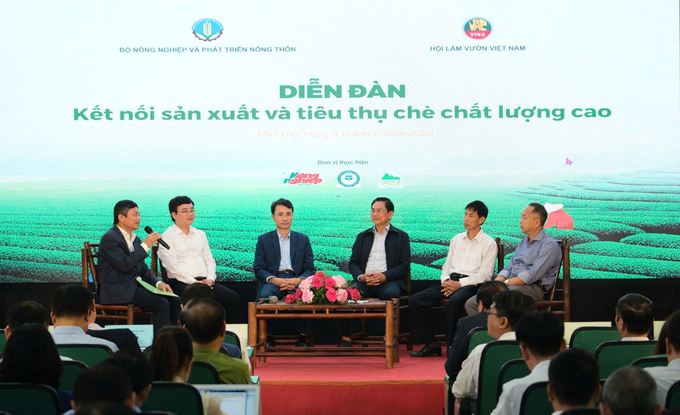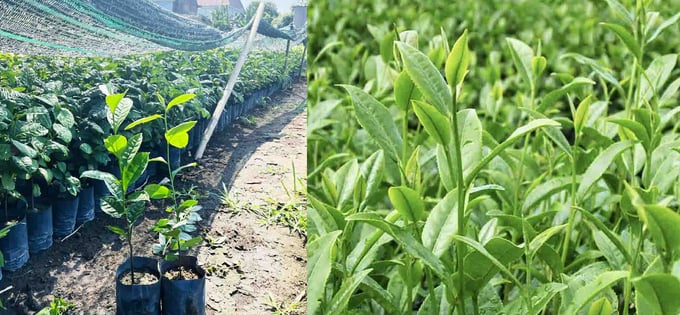November 9, 2025 | 23:49 GMT +7
November 9, 2025 | 23:49 GMT +7
Hotline: 0913.378.918
November 9, 2025 | 23:49 GMT +7
Hotline: 0913.378.918
The tea industry is considered one of the most significant agricultural sectors in Vietnam, as well as in major tea-exporting countries around the world such as China, India, and Sri Lanka.
In order to improve economic value and enhance competitiveness, the role of tea varieties in both production and export plays a critical role. It is a determining factor that directly affects the quality, productivity, and the added value of tea products.
In China, there is a strong emphasis on green tea varieties, with well-known types such as Longjing (Dragon Well) and Da Hong Pao. These varieties are not only unique in terms of flavor but also hold deep cultural significance, making them iconic in Chinese tea culture. The distinct qualities of these teas have helped China maintain its position as the leader in global tea exports.
India, on the other hand, is renowned for its black tea production, with Assam and Darjeeling being two of its most famous and sought-after varieties. These teas are grown in specific regions with ideal climatic conditions, which allow them to develop their rich, robust flavors. As a result, Indian teas are highly valued in demanding international markets, such as those in the European Union and the United States.
Sri Lanka’s world-famous Ceylon tea comes from varieties specifically cultivated in the island’s high-altitude regions. Sri Lanka has built its reputation not just on the unique characteristics of its tea, but also on its sophisticated processing methods and strategic branding efforts.

The forum "Connecting the production and consumption of high-quality tea" recently took place at the Northern Mountainous Agriculture and Forestry Science and Technology Institute (NOMAFSI), located in Phu Ho Commune, Phu Tho Town, Phu Tho Province.
The tea industry in Vietnam, with a development history spanning over 100 years, boasts a diverse and rich collection of tea varieties. These varieties not only form the foundation of tea production but are also crucial elements that influence the yield, quality, and export value of Vietnamese tea in international markets. Although Vietnam is home to over 300 different tea varieties, the majority of the tea produced still belongs to the low-price segment. This is largely due to limitations in both the quality of tea varieties and the processing technology employed. While some high-quality varieties, such as LDP1, PH8, Kim Tuyen, and Huong Bac Son, have been officially recognized for their superior characteristics, they make up only around 10% of the total area dedicated to tea cultivation in the country.
As a result, expanding the use of high-quality tea varieties has become a strategic objective for Vietnam's tea industry. This effort is essential for increasing the export value of Vietnamese tea and improving its position in the competitive global market.
Tea varieties are not only the foundation of the tea industry but also a crucial factor in determining the future of Vietnamese tea in the international market. By developing high-quality tea varieties, building a brand associated with the country’s cultural heritage, and increasing investment in technology, Vietnam can overcome current challenges and establish a strong position in the global tea industry. This approach will help enhance the competitiveness of Vietnamese tea, ensuring its recognition and demand in international markets, while also contributing to sustainable growth in the sector.
According to the Northern Mountainous Agriculture and Forestry Science and Technology Institute, Vietnam currently has around 300 tea varieties, which include some of the most prominent ones such as Huong Bac Son, Tri 5.0, TH12, TH14, LB18, TC4, LCT1, TH22, TH276, VN15 and TH21. These varieties are known for their vigorous growth, high yield, and excellent quality, playing a vital role in diversifying the range of tea products available on both the domestic and international markets.
Between 2019 and 2023, the Institute introduced 16 new tea varieties to meet the growing demand in both local and international markets. These newly developed varieties not only align with Vietnam’s natural climate conditions but are also specifically designed to meet rigorous quality standards and food safety requirements, which are crucial for competing in global markets.
Among the new varieties, Tri 5.0 and Huong Bac Son stand out for their ability to produce high yields while significantly improving the quality of the final product. This advancement is critical in helping Vietnamese tea meet international standards, which is essential for accessing and penetrating highly competitive and demanding markets such as the European Union and the United States.
The diversity of tea varieties enables the tea industry to offer a wide range of specialized products such as green tea, oolong tea, and exclusive specialty teas. These unique products are well-suited to the growing demand for premium beverages in international markets.
At the recent forum "Connecting the production and consumption of high-quality tea", organized by Vietnam Agricultural Newspaper in Phu Tho, experts and speakers unanimously agreed that ancient tea varieties, such as Ta Xua and Suoi Giang, have immense potential if properly invested in and developed into well-established brands. These varieties, with their long history and unique qualities, could eventually be recognized as "national treasures" and gain the ability to directly compete with renowned tea products from countries like China and Japan.

In order for exported tea to achieve high value, the tea varieties must be carefully selected and developed.
For Vietnam's tea industry to escape the "cheap price trap" and enhance its position in the global market, it is essential to research and expand the cultivation of high-quality tea varieties, with a focus on varieties that are suitable for deep processing.
Specific solutions have been outlined, including the urgent need to apply science and technology in cultivation and processing, particularly the use of biotechnology to improve quality indicators such as polyphenol content and amino acids.
Additionally, strengthening the link between farmers and businesses is crucial to ensure a stable raw material supply for sustainable development.
Furthermore, building a strong brand identity through effective marketing and communication that highlights the culture and history of Vietnamese tea is essential to increasing its recognition and value in international markets.
Translated by Phuong Linh
/2025/11/08/3402-1-212706_176.jpg)
(VAN) Viet Nam's fruit and vegetable exports continued to reach an extremely high turnover in October. With this growth momentum, the sector is expected to set a new milestone of USD 8.5 billion in 2025.
/2025/11/08/4950-1-163820_289.jpg)
(VAN) During the 2021–2025 period, Viet Nam's agro-forestry-fishery processing industry has made remarkable progress, achieving an average growth rate of 8%/year.

(VAN) Over 80 years, Vietnamese rice has journeyed through half a century to become a symbol of knowledge, resilience, and the new nation’s agriculture stature.

(VAN) The traders estimated that the lowest price in the tender, closed on Thursday by Bangladesh's state grain buyer, to buy 50,000 metric tonnes of rice was $355.59 per metric ton CIF, liner out.

(VAN) The information shared by Dr. Ngo Xuan Nam, Deputy Director of Viet Nam Sanitary and Phytosanitary Notification Authority and Enquiry Point (SPS Viet Nam), on October 30 during a conference on food safety regulations.

(VAN) Viet Nam mainly exports raw Bat Do bamboo shoots for deep processing, so premium products appear only on dining tables in Japan and Taiwan.

(VAN) Tafa Group CEO emphasized, 'It is essential to strengthen communication efforts so that 'Made in Vietnam’ egg brand not only maintains a strong foothold domestically but also reaches into export markets.'